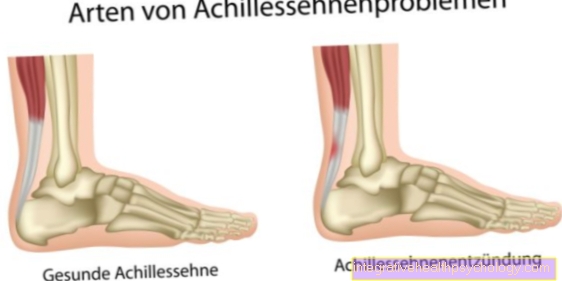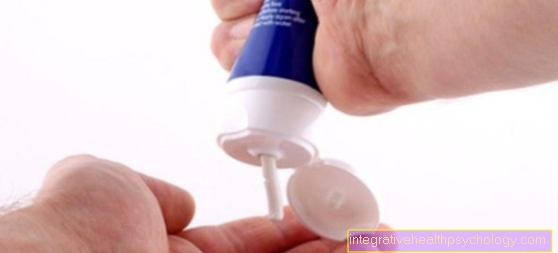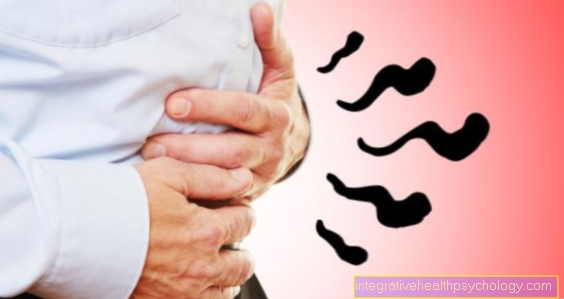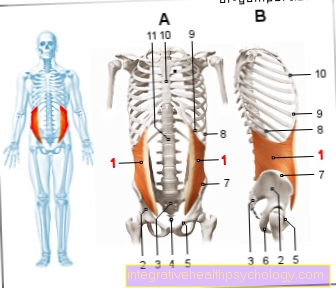Diet for high blood pressure
definition
High blood pressure is generally understood to mean a permanently excessive pressure of the blood in the circulatory system of the body, whereby one speaks of an illness if the measured blood pressure values repeatedly show a value of 140mmHg systemic and Exceed 90mmHg diastolic.
In order to counteract high blood pressure, attacks can be carried out in several places, at the beginning - i.e. before drug therapy - there is usually a change in given living conditions. These include, on the one hand, the reduction of obesity, sufficient exercise, stress reduction and renouncing nicotine, coffee and alcohol, on the other hand, a healthy, balanced diet.

Initiation high blood pressure
In addition to diabetes, high blood lipid levels and cigarette smoking, high blood pressure is an important risk factor for the development of:
- arteriosclerosis
- stroke
- Heart attack
- Heart failure.
In the development of high blood pressure, there are other causes and a close relationship to nutritional factors. What is certain are, above all, excessive table salt intake, caloric overeating and regular increased alcohol consumption.
As early as the 1960s and 1970s, a connection between excessive energy intake, obesity and the development of high blood pressure was recognized. Studies have shown that blood pressure increases in line with body weight. Initially it was assumed that the increased food intake also increased the intake of sodium and that this had a negative impact on blood pressure.
The mineral sodium is widespread in food and is a component of table salt (1g table salt = approx. 400 mg sodium + approx. 600 mg chloride). Only sodium affects blood pressure by binding water and thus increasing blood volume. There is higher pressure in the vessels and thus an increase in blood pressure.
In the meantime, however, the increased insulin level caused by overeating has come to the fore. So-called hyperinsulinism (too much insulin, which is insufficiently effective, is described in detail in the chapter on nutritional therapy for diabetes mellitus) precedes the development of high blood pressure in more than half of the patients.
A reduction in the intake of table salt is recommended for every patient with high blood pressure. However, there are significant differences in sensitivity to table salt.
Not all patients respond to salt restriction with a marked drop in blood pressure. It is therefore assumed that some people are “more sensitive to salt” than others. Which factors lead to this has not yet been clearly clarified. In any case, the common salt intake in Germany is generally too high. Almost all foods and luxury foods contain salt and the average person consumes an average of around 12 g of table salt per day.
The German Nutrition Society recommends 5 - 6 g of table salt daily. This amount is enough to compensate for the mineral loss through sweating.
Using table salt sparingly is also the basis of a general healthy diet. As soon as high blood pressure is present, it is all the more important and recommended to reduce the consumption of table salt. High blood pressure is often linked to diabetes (diabetes mellitus), lipid metabolism disorders and gout (metabolic syndrome). In terms of nutritional therapy, there is a broad field of activity here.
- For mild high blood pressure can and should the attempt of a nutritional therapy lasting several months precede the use of an antihypertensive drug.
- For severe high blood pressure the use of a drug is necessary immediately. However, nutritional therapy should always be accompanied. This can possibly reduce the dose of the drug and thus also side effects.
Read more about this under:
- How can I best lower my diastole?
- Lower systole
What should you watch out for?
Too high blood pressure can - together with other lifestyle changes - be influenced so positively simply by changing your diet and observing one or the other nutritional advice that drug therapy is not required at all or not yet. In general, what should be taken care of is that the Salt intake with food within limits or possibly reduced, but sufficient potassium is absorbed and that the Energy supply adjusted (maintain normal weight, reduce excess weight) and switch to a high-fiber, low-fat diet.
Low sodium diet
Adhering to a low-sodium diet has been shown to lower blood pressure. Therefore, this form of nutrition is recommended for all forms of high blood pressure.
Three diet levels are practiced:
- Strictly low-sodium or low-sodium diet. Sodium content <400 mg sodium (<1g table salt)
- Sodium and low-salt diet. Sodium content <1200 mg (<3g table salt)
- Moderately low-sodium and low-sodium diet. Sodium content <2400mg (<6 g table salt).
The strictly low-sodium diet is rarely used today because it is practically very difficult to produce and too stressful for the patient. In the clinic, the second form is prescribed with 3g of table salt and the third form with 6g of table salt is practicable for the outpatient area for permanent setting.
Here, all foods with a high sodium content must be avoided. These are salted, cured or smoked meat and sausage products, certain types of bread, canned vegetables, ready meals, ready-made soups and ready-made sauces, snack products, salt and salty condiments.
A low-salt diet with less than 3g of table salt can be carried out well in the clinic. Special low-sodium foods such as bread, sausage and cheese are primarily available to clinics and sanatoriums through wholesalers. They are only occasionally offered in food retailers and health food stores.
However, the taste of these products offered cannot be described as satisfactory. Low-sodium salt substitute (mostly based on potassium) is available. The taste of the food is hardly improved by this and in the case of kidney disease, potassium salts must not be used, or only after consulting a doctor. All these products are subject to diet regulations and must adhere to precisely defined criteria for their ingredients.
Since 1988, the food industry has also had the option of offering low-sodium foods in retail stores in addition to these low-sodium and strictly low-sodium diet products. This refers to food groups that experience has shown to contribute to a high salt intake such as bread, sausage, cheese, ready-made meals.
These low-sodium foods are suitable for a moderately low-sodium diet (<6g table salt daily) and can generally help to limit the salt consumption of German citizens. So far, however, there are only very few of these low-salt products on the market because, according to the food industry, demand determines supply and these products are too little demanded and consumed. For people with high blood pressure, the moderately low-sodium diet is offered outside the clinic with <6 g table salt recommended. All foods that are very high in sodium must be left out here. Table salt should only be used very sparingly in the kitchen and should be replaced with other spices and fresh herbs as often as possible. It is important to emphasize the taste of the food and to cook it in a tasty and varied way without salt.
Recommended foods
Which foods are recommended for high blood pressure results from the nutritional advice that recommends a balanced, low-salt, Mediterranean diet.
Regarding meat and sausages it is uncured, low-fat, white meat Recommended, for example skinless poultry, lean beef or veal, boiled ham and roast meats. Generally speaking, the consumption of flesh however on Restricted 2-3 times a week and red meat are as good as avoided.
Much the same applies to fish. Lean, low-fat fish such as plaice, cod, saithe, pikeperch, etc. should be preferred.But also so-called fatty fish, such as Tuna, herring, salmon or sardines can be eaten every now and then as these are rich in good ones Omega-3 fatty acids that may originally help lower blood pressure.
Care should be taken that sufficient fruit and vegetables is consumed, preferably raw or steamed, preferably a small portion with each meal. This ensures sufficient intake of Magnesium, calcium and potassium guaranteed.
Low-fat variants should be used for milk production, such as low-fat milk, low-fat yogurt, buttermilk, kefir, low-fat quark, low-fat cheeses or creamy cream cheese.
Fats and oils should generally be saved, and preference should be given good fats such as sunflower oil, sesame oil, coconut oil or olive oil, i.e. foods that are rich in polyunsaturated fatty acids.
Furthermore, should in the area of bread and baked goods whole grain products can be used, as well as low-fat and low-salt pastries (fruit cakes, yeast dough, quark-oil dough, wholemeal pastries).
The drinks should if possible sugar and alcohol free be tea, low-salt water or fruit and vegetable juices with no added sugar.
Foods to avoid
Since the diet and thus the composition of our ingested food can also influence our blood pressure to a certain extent, it is definitely an option to avoid certain foods or to reduce their consumption in order to benefit from a positive influence on blood pressure regulation.
An important point of attack is the consumption of salt: Salt as a water-binding or water-driving mineral (sodium chloride, NaCl) can, if consumed in excess, contribute to the fact that more water is bound in the body and it is withdrawn from the blood, so that it becomes thick, the flow properties decrease and the Pressure in the bloodstream needs to increase to propel the blood forward.
If there is therefore a high blood pressure, should salty foods (e.g. cured meat / sausage products, smoked / cured fish, salty pastries, etc.) and excessive seasoning of dishes should be avoided.
Also avoided should be the traffic of licorice. Very few people know that this liquorice drives the body's own production of cortisol in the adrenal cortex, which in turn can lead to an increase in blood pressure (cortisol is one of the body's stress hormones).
The consumption of red meat (beef, veal, pork, lamb, sheep, goat) can also promote the development of high blood pressure. Red meat in particular can cause the digestive system to over-acidify. On the other hand, it contains a lot of unhealthy fats that raise the cholesterol level and in the long run increase the risk of vascular calcification and high blood pressure.
Finally, various luxury foods like Avoid alcohol, coffee, and cigarettesn be. What they all have in common is that they can have a direct influence on blood pressure: they activate the sympathetic nervous system, thus increasing the heart rate and also cause the blood vessels to become narrower - everything together increases blood pressure.
A reduced consumption or even a complete waiver is therefore beneficial for health.
Nutritional example
As a roughly oriented nutritional example, the following can be used Daily overview serve - this is only an exemplary compilation of recommended foods, the method of preparation can be varied individually and the foods can be exchanged for those of equal value:
- In the morning: Whole grain bread with cold cuts of your choice, lean sausage products (poultry, boiled ham) or low-fat cheese. Low-sugar muesli with low-fat milk and fruit (e.g. banana, pear, apple, etc.). Low-fat yogurt or low-fat quark with fruit. In addition, water, tea or fruit / fruit juices without added sugar.
- Noon: Rice, pasta, potatoes with vegetables (e.g. broccoli, peppers, tomatoes, carrots, etc.), possibly with low-fat fish or white or low-fat meat (only add 2-3 times a week). It should be ensured that the seasoning is not too salty.
- in the evening: Whole grain bread with low-fat cold cuts or spreads.
Spread over the whole day enough liquid in the form of non-alcoholic, sugar-free drinks such as water, tea or fruit juices without added sugar (1.5-2 liters per day).
other attention ...

Weight reduction when overweight
Is your body weight over you BMI (body mass index) of 25 a weight reduction must occur. Ideally with a moderately energy-reduced, fat- and fat-modified balanced mixed diet. The reduction in table salt results automatically from the reduced food intake.
By reducing high-fat sausage and cheese a sodium saving is achieved that is achieved with a daily caloric intake of no more than 1000 calories can be considered sufficient. With higher energy intake, however, foods that are very high in sodium should always be eliminated from the menu.
Restriction of alcohol intake
More than 20 g of alcohol (in men, in women 10g) shouldn't be daily. Alcohol abstinence is generally recommended.
Increase in potassium intake
People who do not use table salt and have a relatively high amount of potassium (from vegetable food) do not know about hypertension. Potassium appears to be the antagonist of sodium in the development of high blood pressure. Increased potassium intake can be achieved if one follows the principle of Food pyramid nourished and consumed whole grain products 2 servings of fruit and 3 servings of vegetables.
Further therapeutic measures
In addition to changing your diet and observing certain dietary rules, other non-drug measures can help lower your blood pressure.
A change in diet is often accompanied by weight reduction: if you already have a normal weight, you should ensure that it is maintained. If you are overweight, you should aim for a BMI of <25kg / sqm (1kg weight reduction can reduce blood pressure by 2mmHg).
Care should also be taken to ensure that there is sufficient exercise: at least 30 minutes of physical exercise 2-3 times a week, ideally in the form of endurance sports such as cycling, swimming, Nordic walking or running is beneficial. Read more about this under: Exercise for high blood pressure
It is important to reduce the existing stress as much as possible, to get enough sleep and to incorporate specific relaxation phases into everyday life. Finally, the consumption of cigarettes / coffee / alcohol can or should be reduced or even given up, as these luxury foods lead to an increase in blood pressure or make it more difficult to reduce the existing high blood pressure.
If all these lifestyle changes are not satisfactory and the high blood pressure is still there, the doctor may then have to intervene with medication: various antihypertensive drugs that attack different parts of the bloodstream are prescribed individually in order to achieve normal blood pressure and prevent consequential damage.
Read more about this under:
- High blood pressure therapy
- Homeopathy high blood pressure
Summarizing general tips
In summary, general tips and hints can be given that can be used as a first attempt to remedy the existing high blood pressure, but can also generally be viewed as preventive measures beforehand:
A reduction of the possibly existing overweight (goal is a BMW <25kg / qm) or the maintenance of the Normal weight is a goal. This can be achieved through sufficient Sports (2-3 times a week approx. 30 minutes) and one balanced, Mediterranean dietthat should be kept low in salt.
Avoiding hypertensive stimulants such as coffee, nicotine and alcohol is just as important as that Reduction of stress in everyday life. Targeted recovery phases during the day (for example through yoga, muscle relaxation according to Jakoben etc.) and adequate sleep can already be the first approaches.





























